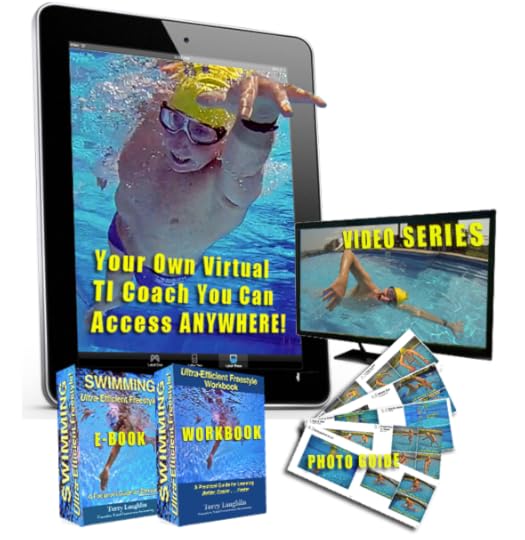Terry Laughlin's Blog, page 7
October 19, 2018
VIDEO: Work Less, Swim Better –“Perpetual Motion Freestyle” at Multisport World Expo
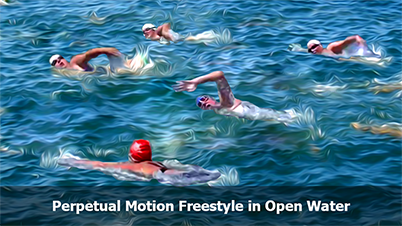
Terry (center) at 2006 Masters World Championship
In a blog post two weeks ago, we shared the “Endurance Skills” practice set that Terry Laughlin (founder of Total Immersion) offered in swim clinics that he taught at the Multisport World Expo at MIT in 2009. At that same expo, Terry also gave a lecture– with illustrating video demonstrations– on the skills of what he termed “Perpetual Motion Freestyle”– a fluid, smooth, and efficient stroke that is designed to endure over long distances, and is particularly well-suited to open-water swimming. This week’s blog highlights a thoroughly-indexed breakdown of his lecture, including embedded video, annotated with time signatures, so you can click ahead to specific aspects of the discussion that most interest you.
To watch Terry’s talk in its entirety, click here: Perpetual Motion Freestyle YouTube Playlist (7 videos)
What is “Perpetual Motion Freestyle?” (2:53)
Demonstration of the perfected Perpetual-Motion freestyle by Terry Laughlin– both in practice and racing– in open water, pool, and the Endless Pool
0:01 – Terry Laughlin’s freestyle in open water
0:32 – The Perpetual-Motion freestyle stroke in an Endless Pool at the T.I. Swim Studio
1:30 – Terry demonstrates fast, smooth open water racing in the 2006 Masters World Championship
Expo Talk, Part 1: Total Immersion Perpetual Motion Freestyle (12:48)
Philosophy and Freestyle Misconceptions:
0:01 – Terry’s Early Struggles with Swimming
4:39 - Four World Masters Championships in the Last Three Years
5:50 – The Huge Difference Coaching Makes
6:35 - The Aesthetic Approach to Coaching
7:17 - The Improvement-Oriented Swimmer
7:53 - Work Less, Swim Better
8:40 - Shaping Your Body as a Fuselage
9:00 - What WON’T Make You Faster
12:30 – What WILL Make You Faster
Expo Talk, Part 2: Total Immersion Perpetual Motion Freestyle (9:23)
0:01 – Propulsive Forces v. Resistive Forces: Winning the Battle
1:14 – Sustainability, Not Velocity
3:55 – Stroke Length x Stroke Rate
4:37 - Why Work Less? The Three Percent Solution
8:10 – Active Streamlining: Swimming with Less Drag
Expo Talk, Part 3: Total Immersion Perpetual Motion Freestyle (9:59)
0:01 - Manhattan Island Marathon: Motor Endurance & Mental Endurance in long-distance
1:28 – Path of least resistance: cooperate with gravity, legs draft behind torso
3:09 – Weight shifts for propulsion (integrated core body power v. “pulling” and “kicking”); skip to 3:30 to view footage & analysis of Terry racing in 2006 World Masters Championship
5:32 – Pool footage: “Human swimming” vs. T.I. “Fishlike” Perpetual Motion Freestyle
7:09 – Relaxed hand with palm down– better traction in catch; Michael Phelps’s early vertical forearm
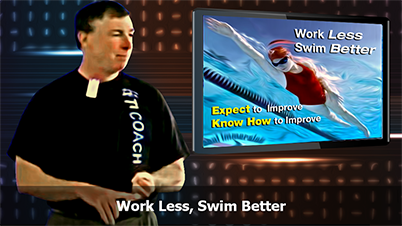
To continue watching Parts 4, 5, and 6, view the full Perpetual Motional Freestyle YouTube Playlist, or click on time signatures below:
Part 4: 0:01 – Propulsion; 1:05 – Creating the “Perpetual-Motion” Freestyle; 2:22 - Release Your Head; 3:14 – Rotate “Just Enough”; 7:05 – Skating Practice
Part 5: 0:01 - The X/Y Coordinates for the Reach; 0:50 - The Underswitch; 1:50 – Propel by Driving the High Hip; 3:22 - The Zen Switch; 5:08 - Question and Answer
Part 6: 0:16 The Reason Why Some People Are Sinkers; 0:34 The Surprising Facts about Achieving Buoyancy; 1:07 The Benefits of the Superman Glide; 1:39 The Importance of Breathing on Both Sides; 2:44 The Proper Arm and Hand Position When Swimming
The post VIDEO: Work Less, Swim Better –“Perpetual Motion Freestyle” at Multisport World Expo appeared first on Total Immersion.
October 12, 2018
Guaranteed to Improve Stroke Length: A Tempo Trainer Practice Set
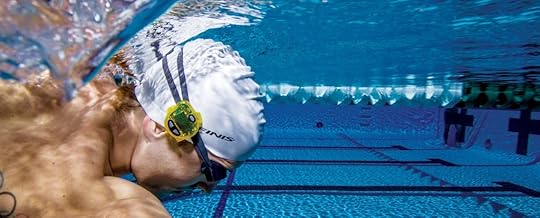
(Pictured above: Tempo Trainer Pro by Finis )
Last week’s post on “Endurance Skills” illustrated a practice set that included the use of the “Tempo Trainer” pacing device– a waterproof electronic “metronome” worn while swimming– in one of the sets. Terry Laughlin was an enthusiastic proponent of the Tempo Trainer, and it was one of the few “pool tools” that he recommended and used regularly in his own practice and training. Describing the Tempo Trainer’s effectiveness, Terry wrote:
“You learn to improve your rhythm, pace, and speed without sacrificing efficiency. The TT focuses you. The audible beep keeps your attention on each stroke you take and helps banish distraction. The TT improves your rhythm. Consistent rhythm is an essential skill of successful swimming. It’s also the quality that harmonizes the various elements of the stroke. The TT teaches unerring pace. Sense of pace is usually thought of as a trait you just have or acquire through endless repetition. The TT is a fast, and almost effortless, way to learn this critical skill. Just keep strokes per length (SPL) consistent and synchronized to the beep as you swim farther. If SPL and Tempo remain steady, so does pace.” (For a full description of this product or to purchase your own Tempo Trainer, click HERE .)
Below is a great example of a short practice set (posted by Terry on the T.I. forum in January 2011) that shows how to increase stroke length through precise adjustments to one’s stroke tempo, with the use of the Tempo Trainer and counting strokes per length (SPL).
Click HERE to view Terry’s archived (“read only”) original post on the old forum and subsequent discussion of this practice set.
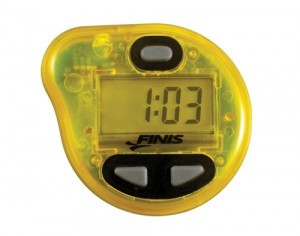
(Above: Tempo Trainer Pro by Finis)
Practice Set To Improve Stroke Length
Try this exercise with Tempo Trainer. You may need to experiment a bit to find the tempo range that suits you best.
Swim 10 x 25. Reset TT by 0.1 sec. each time. On 1st 5, reset TT slower each time. On next 5, reset TT faster each time.
Count strokes on each 25 and compare.
Here’s an example:
1.6
1.7
1.8
1.9
2.0
1.9
1.8
1.7
1.6
1.5
How many strokes did you start with?
How many did you subtract as tempo slowed?
Was your SPL (strokes per length) the same or fewer when you returned to starting point (9th 25)?
Was it still the same or fewer when you finished? (0.1 faster than starting)?
Allow 3 beeps on all pushoffs to keep that part consistent.
I encourage you to do this initially at a range that takes you to a slower tempo than you have ever swum at, such as the example given. For Freestyle, I’m not sure there’s a benefit to swimming above 2.0, but my experience going as high as 2.0 was eye-opening. Until I did the set as outlined above, I’d never used a tempo slower than 1.5. I found that from 1.8 to 2.0 any balance flaws I had became exposed. And with the tempo as slow as it was, I could sense where and why they occurred.
You can also do this with 50s. Allow 4 extra beeps on turns. Count total strokes for 50.
I plan to repeat this once or twice a week. I’ll do it either as a start-of-practice tuneup, or at the end of effortful practices to re-tune my stroke and send me to the showers feeling great.
I’ll do it both with 25s and 50s, and will probably start at a slower range, and use incrementally faster ranges over time.
I also plan to do this with Backstroke.
If you do the set, in any form, please share your results here. And if you find they improve over time, please share that too.
Eventually I want to be doing this set starting @ 1.0 and finishing @ 0.9. I’ll let you know how it goes.
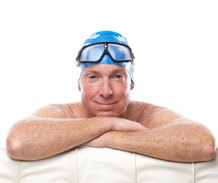
In the original forum discussion (archived from 2011, in “read only” format) that followed Terry’s posting of this set, one T.I. forum member wrote this feedback to Terry:
For me, this exercise taught me that I didn’t have to think so hard about high elbows or try to grab the water. As I slowed down and focused on hitting the beeps, my muscles automatically adjusted and I became more efficient. Then, when I started picking up the pace, that streamlined, efficient feeling was still fresh in my “muscle memory” and it carried into the faster tempo. At this point, I am not really concerned with going faster, but if I were, I guess the first thing I would do is find ways to reduce my drag, rather than generating more propulsive power. My stroke length would go up and then it would be a matter of math and playing with tempo to find the pace I could maintain.
I swam about 30 min. today, and just wasn’t feeling it. So I did the exercise again and it worked like a charm. Single lengths this time:
1.6 16 strokes
1.7 15
1.8 14
1.9 13
2.0 13
1.9 13
1.8 14
1.7 14
1.6 15
1.5 15
Terry’s response to this forum member’s feedback was this:
You totally grasp the value of this practice. It greatly increases the likelihood that the improvement – then retention – of efficiency will be a natural process, one done far more by feel than thought. And though you weren’t concerned with going faster, in fact that was precisely the outcome. A 15-SPL lap at 1.5 is 1.5 sec faster than a 16-spl lap. The best kind of speed is that which comes without “trying.”
The post Guaranteed to Improve Stroke Length: A Tempo Trainer Practice Set appeared first on Total Immersion.
October 5, 2018
Endurance Skills: A Practice Set To Improve Balance, Streamline, and Focus

FROM THE ARCHIVES : This practice set from Terry is one that he posted on the T.I. discussion forum on 3/22/11, following a clinic at the Multisport World Expo. He wrote:
“Saturday Mar. 19 [2011], at the Multisport World Expo at MIT in Cambridge, MA, we offered 75-minute classes in Endurance Skills. These focused on whole-stroke repeats with Focal Points designed to improve Balance and Streamline. During the final 20 minutes, we used Tempo Trainers to consolidate the new thoughts and skills. Here’s a practice based on what we did at those classes. If you do this practice, please post any insights or improvements that result.”
To view Terry’s original forum thread, and the ensuing online discussion that followed his post of this practice, click HERE. And feel free to post any observations in the comments below, after you’ve had a chance to try this practice yourself.
Enjoy– and as Terry always said, “Happy Laps!”

(Archival photo: Terry coaching a T.I. clinic in Coral Springs, FL, circa 2008)
Total Immersion Mindful Swimming Practice
Mindful Swimming Practice has a dual purpose:
1) Train your body. Focus on an aspect of stroke improvement that allows you to sense and measure improvement with some ease. Repeat a narrowly focused technique enough times to leave an imprint on muscle memory.
2) Train your brain. Practice holding one specific thought. If you notice your thoughts have wandered, bring them back. At the end of each set, evaluate how well you’ve maintained focus, just as much as you evaluate how you’ve changed your stroke. Improving focus will have longer-lasting and more expansive benefits than improving your stroke.
Tune-up
Swim 50 yards. Count strokes.
Swim 6 x 25. Odd 25s with index-finger-only extended. Even 25s with ‘normal’ hands.
Compare SPL (Strokes Per Length) one finger to normal hand. Can you reduce the difference between them?
Swim 50 yards as before. Count strokes. Did 50-yd count change?
Balance/Relaxation Focus
Swim 4 to 8 x 25 with this focus:
Hang Your Head Feel head hanging – weightless – between shoulders. Focus only on keeping a sense of a weightless head and relaxed neck & shoulder muscles.
Swim 4 to 8 x 25 with this focus:
Weightless “Lazy” Arm Feel your arm float forward as if cushioned. How slowly can you extend? Notice if fingers are tense or relaxed. Look for– and eliminate– bubbles.
Swim 3 to 5 x 50 [25 Hang your Head + 25 Weightless Lazy Arm]
Streamline/Swim Taller Focus
Swim 4 to 8 x 25 with this focus:
Swim Slightly Taller Reach a bit farther than usual – as for something barely beyond reach. Don’t strain, but aim to extend reach by a couple of millimeters or nanoseconds.
Swim 4 to 8 x 25 with this focus:
Overlap Slightly increase overlap between hands. Overlap enough that you notice it, but not so much that it feels out-of-rhythm.
Swim 3 to 5 x 50 [25 Swim Taller + 25 Overlap]
Combined Focus
Swim 3 to 5 x 50 [25 Combined Relax Focus + 25 Combined Taller Focus]
Tempo Trainer (TT) Pyramid
[Note: To learn more about the Tempo Trainer, click HERE]
Swim 10 x 25. Reset TT after each: 1.3 – 1.4 – 1.5 – 1.6 – 1.55 – 1.50 – 1.45 – 1.40 – 1.35 – 1.30
Choose any focus from those above to maintain for the entire set.
The goal of this set is to improve efficiency (reduce SPL) as tempo slows, then be very ‘stingy’ about giving back the strokes you saved, as tempo increases again. As tempo slows, you’ll notice extra time in the stroke. Use this time to extend a bit further (as in Swim Taller focus) and be more patient about beginning the stroke.
Take Note of: (1) SPL at start of set; (2) how many strokes you ‘save’ as tempo slows from 1.3 to 1.6; (3) SPL at finish of set; (4) at which tempo you feel most comfortable.
SPL Maintenance Set (without TT)
Swim 4 x 25 + 3 x 50 + 2 x 75 + 1 x 100.
Goal is to maintain SPL within two strokes of best count from TT Pyramid, as repeat distance increases.
The post Endurance Skills: A Practice Set To Improve Balance, Streamline, and Focus appeared first on Total Immersion.
September 28, 2018
Balance: The Essential Foundation of Efficient Swimming
An exclusive excerpt in an ongoing series of material from Terry’s forthcoming final book, Total Immersion: Swimming That Changes Your Life

In our last blog post, we released the second excerpt– on “Seamless Breathing”– from the unpublished draft of Terry Laughlin’s final book (currently being edited, for anticipated release sometime in 2019). This week’s post is another exclusive excerpt from his final book, on the topic of “Balance.” Like the previous excerpt, this article is adapted from a section of the book entitled, “Stroke School: Effortless Endurance Freestyle in 8 Lessons”– below, Terry outlines 3 specific steps (or “mini-skills”) to achieve better balance. To introduce this chapter on balance, we’ve included a quote from one of Terry’s private, audio-recorded conversations with his family during his last days in October 2017. Here, he speaks passionately about what he most hoped to convey about swimming in this final book:
“The T.I. approach to swimming is unique in recognizing that, as human beings, we naturally approach the water in the posture of a survivor. It’s a primal thing. That’s a fundamental insight to understand what’s different about T.I.– and that’s the reason for our success. If an instructor doesn’t take the step of helping a swim student overcome that fear, the swimmer will always be surviving rather than swimming. You have to help the student feel safe and secure before they can become a swimmer. Otherwise, they will always be swimming as a survivor. That’s what balance does– it makes you feel safe, secure, and in control. What makes Total Immersion distinctive is teaching balance as the keystone skill of swimming. No one else even recognizes balance as a skill let alone the keystone skill of swimming efficiently. And not just swimming efficiently, but being able to enjoy swimming– being able to swim with ease, grace, and enjoyment.” — Terry Laughlin, 10/13/17
Balance: The Essential Foundation of Efficiency
To swim efficiently, you must master Balance first. I’d go so far as to call it “non-negotiable.” But the effect of learning Balance can be much more far-reaching. It certainly was for me.
In September 1988, I met Coach Bill Boomer at a coaching clinic and learned that “the shape of the vessel matters more than the size of the engine.” Boomer also said that Balance is the foundation of vessel-shaping– his term for streamlining your body. Though I’d been swimming for nearly 25 years, and coaching successfully for 16 years, prior to that day I’d never heard a single mention of Balance as a swimming skill—much less the most important one.
Soon after, I visited Boomer in Rochester, NY to learn more about “vessel-shaping” and watch him coach his University of Rochester swimmers. While there, I asked Boomer to show me how to balance. He had me perform a drill, while kicking lightly in a prone position with my arms at my sides. When I aligned my head and hips, as instructed, and shifted weight forward to my chest, my hips instantly rose to the surface and my legs felt light. I was moving just as fast, but with a noticeably easier kick.
I repeated the drill several times, memorizing these new sensations, then swam a length of whole-stroke. My stroke felt stunningly different. For 25 years, my legs had felt “heavy.” But after just a few minutes of practicing a simple drill, they felt light!
While the new ease I felt was exciting, the effect of the experience of swimming in balance would be much more far reaching. It changed my whole sense of what was possible—for me and all swimmers:
1.) I’d swum only sporadically, and without real enthusiasm, for nearly 20 years since college, with no purpose other than to get exercise. Since that day, I’ve become a passionate swimmer, and my passion for swimming has only grown.
2.) Prior to that day, the only changes I’d experienced in my swimming had been marginal and temporary. After months of hard training, I could swim longer and faster— but that effect disappeared as soon as I stopped training. The change I experienced through Balance was more dramatic than anything I’d ever known, and has become permanent. Not only do I now feel positively brilliant time I swim but—even after missing practice for several weeks—I recapture that feeling upon my return.
3.) Experiencing such a fundamental and striking change made me realize that, though I’d swum for almost 25 years that day, I still had much to learn. And in fact, I’ve continued to learn new skills and discover new insights (kaizen-style!) for over 25 years since.
4.) At age 37 (when I was introduced to Balance), I thought my best swimming was 20 years behind me. In reality, the best was yet to come! As a result of learning Balance, and many other discoveries that followed, I’ve improved continuously through my 40s, 50s, and 60s.
No More Struggle
The most limiting aspect of swimming is the sinking sensation. When your hips and legs drag below the surface, it’s impossible to feel comfort or ease, your endurance and speed are sapped, and your arms and legs are so preoccupied with fighting the sinking sensation, they’re limited in their ability to aid in streamlining or propulsion.
Poor balance is the reason only 30 percent of us can swim 25 meters. Besides the fact that “survival swimming” is exhausting, the sinking sensation makes it impossible to enjoy swimming—or to anticipate a brighter future in swimming. That constant sense of lacking control in the water also blocks the calm focus needed to learn new skills.
However, if you can solve such profound problems, you should also gain a sense of confidence in dealing with future challenges that you may face.
When you eliminate the sinking sensation—and feel a sense of control over your body—you immediately feel much more “at home” in the water. You also achieve the foundation for every skill that follows.
Three Steps to Balance
As you’ll see, none of these “mini-skills” are instinctive. To learn them, patiently give your full attention to just one skill at a time. The first two of these steps apply to all strokes and are universal requirements to achieve efficiency as a swimmer. The third step is particular to freestyle.
Focal Point #1: Release and align your head
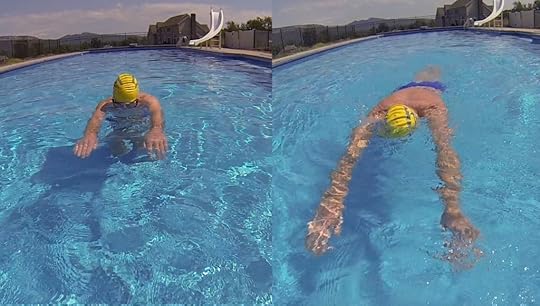
Terry demos releasing a “weightless head” (Photo credit: Robert Fagan/usiavideo)
Releasing your head to a “weightless” position that aligns with your spine is the most immediately impactful and fundamental Focal Point among all the efficiency skills taught by Total Immersion. To allow your head to find its most natural position, just let it go! Relax your neck and upper back muscles until you feel your head’s weight resting fully upon the water. While this action seems fairly simple, our head-lifting instinct is so deep-rooted that it may take months to overcome.
Having done this, check that the crown of your head and spine feel connected by a straight line. When head, spine, and hips are aligned, the head’s 10-lb weight helps counter the downward pull of gravity on your dense lower body.
As you’ll learn in a later chapter, keeping your head aligned and weightless while breathing is even more challenging, because the “survival” instinct to lift the head to breathe is primal.
Make these head-position skills your first “efficiency checkpoint” for the rest of your swimming life. Thirty years after I first focused on aligning my head and spine, I still re-check it regularly and often find room for improvement.
Focal Point #2: Reach below your body

Terry demos reaching below the body, fingertips-down (Photo credit: Robert Fagan/usiavideo)
Before extending your arm in freestyle, enter it cleanly (eliminate noise and splash) and earlier than you think you should. Then reach on a moderate (not steep) downward slope as you extend forward. Reach full extension with the hand below the body-line. Extending your arms at a slight downward angle helps lift your legs closer to the surface, reducing drag and freeing up leg muscles to help with propulsion (as opposed to kicking reflexively, to combat sinking).
Focal Point #3: Minimize your kick
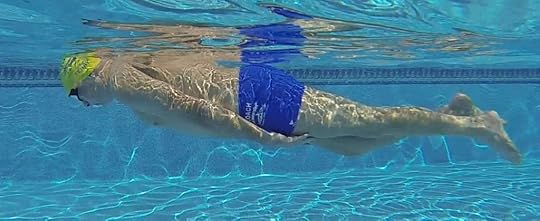
Terry demos Balance w/relaxed legs– arm extension not pictured (Photo credit: Robert Fagan/usiavideo)
Recall that Tim Ferriss’s and Vik Malhotra’s [mentioned earlier in the book] instructors handed them kickboards to “strengthen their legs” in an utterly futile effort to improve their body position. The action of balancing the body does exactly the opposite: by making your legs lighter, being in balance allows you to significantly calm and relax your kick—as I discovered when doing Boomer’s balance drill.
Complement this by relaxing your legs as much as possible. This will also help prepare you for the highly efficient 2-Beat Kick (2BK), which we explain in a later chapter.
Balanced Body, Focused Mind
The effects of balance practice on your mind and psyche are as profound as those on your body. Total Immersion’s balance learning sequence—in combination with structured use of balance-oriented Focal Points—has been designed to prepare you cognitively, as well as physically, for a successful learning experience.
A combination of targeted mental focus, with unhurried movements, and moderate heart and respiration rate, puts the brain into a state of relaxed alertness known as the Alpha brainwave pattern (8 to 12 cycles per second.) Cognitive scientists call this state “the super-learning zone.”
Learning, practicing, and feeling Balance creates a “virtuous loop.” You feel good physically and mentally while Swimming in Balance. That motivates you to do it more–which results in improvement to those positive feelings. Thus, you spend even more time Swimming in Balance.
Learn the skills of balance and the other elements of efficient freestyle with the Total Immersion Effortless Endurance Self Coaching Course.
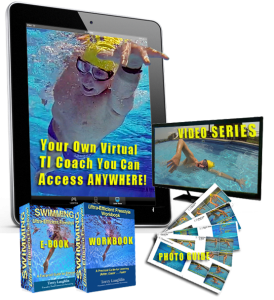
The post Balance: The Essential Foundation of Efficient Swimming appeared first on Total Immersion.
August 24, 2018
Seamless Breathing: The Final Piece in a Super-Efficient Stroke
An exclusive excerpt in an ongoing series of material from Terry’s forthcoming final book, Total Immersion: Swimming That Changes Your Life

In a blog post last month, we released the first excerpt– on “Deliberate Practice”– from the unpublished draft of Terry’s final book (which is currently being edited, for anticipated release sometime in 2019). This week’s post is another exclusive excerpt from his final book, on the topic of “seamless breathing.” This article is adapted from a section of the book entitled, “Stroke School: Effortless Endurance Freestyle in 8 Lessons,” which Terry worked on last summer. In the opening of this piece, Terry first discusses the unique breathing challenges inherent in swimming; then he offers a detailed tactical approach to developing a smooth, rhythmic breath in freestyle.
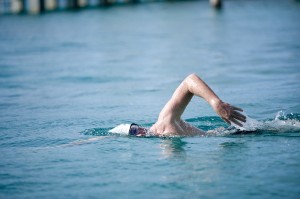
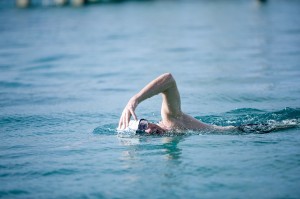
(Terry demonstrating a seamless rhythmic breath while swimming freestyle)
Breathing in freestyle is the most complex and challenging skill in all of swimming. Breathing—regardless of the stroke—is much more than a skill. Breathing has panic-inducing potential for many beginners and is the main reason why fewer than 30% of American adults can swim 25 meters. Even after dozens of traditional lessons, Tim Ferriss and Vik Malhotra [TI students referenced earlier in the book] could swim no further than 15 meters, because they could not get the air needed to swim farther.
But significant breathing errors in freestyle persist even among elite swimmers. In 1997, I analyzed stroke videos for the US National Team at training camp prior to the World Championships. While reviewing underwater video with one swimmer, I pointed out that her lead hand scooped upward on each freestyle breath. This put her out of balance for an instant—something none of her coaches had caught or corrected in all her years of advanced training. In that instant, she increased her kick to compensate for the momentary loss of body position. It also put her hand in a less effective position for trapping water.
How is it possible that some of the world’s fastest swimmers still display such a fundamental weakness in their stroke? Very likely, they developed poor habits as young and unskilled swimmers—lifting the head because of poor balance. And because they were probably faster than peers at every stage, their coaches overlooked errors that only become apparent when studying underwater video, one frame at a time.
Small improvements in breathing technique can add up quickly– and it’s likely your improvement opportunities are much greater than those of champion swimmers. By learning the techniques described below, you can maintain a sleeker bodyline while you breathe.
Two Universal Breathing Challenges
1.) Breathing has Panic Potential
Running is often referred to as primal—something for which evolution has prepared us well. The only thing primal about swimming is a healthy respect for water’s perils– a respect that rises to the level of phobia, or even panic, in some.
Those perils—choking and sinking—are mutually reinforcing. Fear of choking causes us to lift or lunge as we breathe . . . which makes us more vulnerable to sinking . . . and thus more likely to choke. No wonder beginners have such a hard time of it.
The very first Focal Point in the TI learning sequence instructs you to release your head to feel the water’s support. This improves balance. It also helps quiet “lift-and-lunge” breathing instincts.
2.) Breathing is a Skill
The primary reason that people who hardly break a sweat while running a 10K can become exhausted in as little as 25 meters of swimming is the difference in the seemingly simple act of getting air. On land, air is there for the taking. But while swimming—particularly in freestyle—it’s an exacting skill.
To get a breath, we must move the head (nearly 10% of body mass) to the air. The moment we start lifting and turning the head toward the air, every other skill we’ve worked hard to learn breaks down. Drag increases and arms and legs get diverted from propulsion into “sinking-avoidance.”
In experienced swimmers, this moment of breathing passes in a fraction of a second—but is repeated 30 times a minute. In a newer swimmer, such as an aspiring triathlete, it is often the main barrier to progressing from short repeats to a continuous—and easy—mile. Solving these problems will allow you to swim almost any distance with the ease of “conversational” running.
Here’s the good news: As with the other essential skills of efficient swimming, a series of proven steps will teach you the skill of seamless breathing. These mini-skills fall into two categories—how to exchange fresh for stale air, and how to keep stroking efficiently as you do.
Mini-Skill #1 Get Fresh Air In
It may surprise you that simply getting air into and out of your lungs is a skill. But, in the water, we encounter two unique complications:
You face resistance from water pressure while exhaling.
You exhale for much longer than you inhale—a bit like a singer holding a note, then taking a “bite” of air between phrases.
Improve your air exchange with 4 Focal Points:
Push air out. Exhaling should be an intentional and energetic action. When you emphasize the exhale, the resulting inhale happens as air rushes to ‘fill a vacuum’ in your lungs.
Keep it moving. Never hold your breath or interrupt your air exchange—not even for a nanosecond. Breath-holding causes tension . . . and does nothing for buoyancy. Begin exhaling as soon as you finish inhaling.
Finish strong. Exhale forcefully as your mouth reaches the surface—as if trying to blow the water away from your mouth.
Get just enough. There’s no need to completely fill–nor empty–your lungs. Get “just enough” air. Inhaling and exhaling in swimming should feel much the same as singing.
Mini-Skill #2 Maintain Stroke Efficiency
Having spent countless hours “shaping your vessel,” learning to hold your place as you stroke, and connecting your kick to body rotation, you’ve now come to a challenge with the potential to undermine everything you’ve done thus far to improve stroke efficiency.
Rhythmic breathing in freestyle is the most exacting of all skills because:
You must fit the breath into an alternating-arm rhythm; and
Nearly 10% of your body mass (your head) is moving to the side, while the rest of you is moving forward.
Cut these challenges down to size by imprinting 3 habits:
Breathe with head and spine aligned: Don’t lift your head.
Breathe with body roll: Don’t turn your head.
Maintain the shape of your vessel. Keep bodyline long and balanced—and lead arm positioned to hold the water—as you breathe.
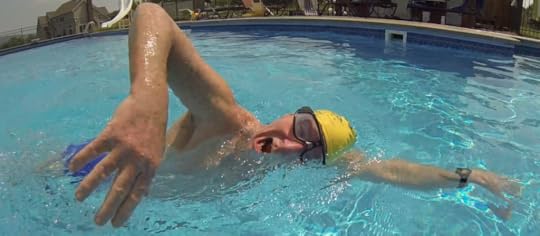
Focal Point #1: Keep Head Aligned.
Progress patiently through three ways of thinking about, and experiencing, a weightless, aligned head:
Weightless Does your head feel as weightless during the breath as it does on non-breathing strokes?
Cushioned: Do you feel the water ‘cushion’ the side of your head as you breathe—just as it cushions your face before breathing?
One-Goggle: As an exercise, try to breathe with only one goggle above the surface.
Focal Point #2: Follow Your Shoulder.
Your pull and kick are most efficient when they’re part of a whole-body action. This is true for breathing as well. Never move your head on its own. Always fit breathing seamlessly with the action of the body. Here’s how to do this when breathing to the left:
As your right hand enters the Mail Slot, your left shoulder rotates up and back. To breathe, simply let your chin follow your shoulder. This integrates the breath with body movement and minimizes the chance of your head moving by itself.
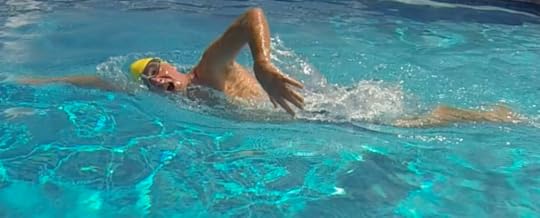
Focal Point #3 Stay Tall
Staying with the example of taking a left-side breath:
Continue extending your right hand as you rotate (follow your shoulder) to air.
Keep that arm extended—below your body with palm back—for as much of the inhale as possible.
Start the right-hand stroke only as your head begins to return to neutral.
Both Sides Now
In August 1972, in the first 10 minutes of the first workout I ever coached, I noticed that every swimmer on the team I’d just begun coaching had asymmetrical strokes. Those who breathed to the left torqued noticeably in that direction; right-side breathers did the same to the other side.
While I had no formal knowledge of stroke mechanics at the time, instinct told me that these excessive sideways motions probably hurt efficiency. When I instructed the team to breathe to the “wrong” side the next day, their lack of symmetry disappeared. Before long, I made it a standard requirement for the swimmers I coached to breathe bilaterally during practice.
Earlier, I wrote that a primary reason breathing in freestyle is such a frequent occasion for stroke errors is the difficulty of keeping the body aligned, stable, and traveling forward when 8% of body mass (the head) repeatedly moves to the side. When we move the head only to one side, it’s inevitable that, over time, the body accommodates these uneven forces in various ways—none of which promote efficiency.
Though I required my swimmers to breathe bilaterally as early as the 1970s, when I got serious about improving my own efficiency in the early 1990s, I was still a unilateral breather—breathing almost exclusively to the left, as I’d done since 1964.
One day in March 1992, I decided to breathe to the right for an entire 800-meter swim. I was swimming in Los Banos del Mar, a 50-meter pool in Santa Barbara. For some time, I’d made it a habit to count my strokes. It really got my attention that my stroke count improved from 41 SPL (strokes per length) breathing to my habitual left side to 39 breathing to my unfamiliar right side. Though breathing to the right felt awkward, that measurable improvement in efficiency motivated me to continue. For several months, I breathed more to the right than to the left, which helped me adapt more quickly. I’ve been a bilateral breather ever since.
If you’ve always breathed to one side, it will feel awkward for a time. There will be a learning curve. But if you apply the series of Focal Points above to breathing on your weak side as well, you’ll soon feel much more comfortable.
Don’t be surprised if eventually your awkward side feels smoother and more comfortable than your natural side. That’s been true for me for 10 years. And because of insights and awareness gained from my more-efficient right side, my natural left side is strikingly more efficient today than it was when I only breathed one way.
Your primary goal is to make your left and right sides identical in every regard. I guarantee that the effort to do so will make you a far more efficient swimmer.
Learn seamless breathing and the other elements of efficient freestyle with the Total Immersion Effortless Endurance Self Coaching Course.
The post Seamless Breathing: The Final Piece in a Super-Efficient Stroke appeared first on Total Immersion.
August 17, 2018
Guest Post: What’s The Link Between Efficient Swimming & Efficient Solar Car Design?
Engineering professor at SUNY New Paltz and “Swim Dad” Mike Otis compares the aerodynamics of designing solar cars to the hydrodynamics of T.I. technique that enabled his daughter Katie to refine her strokes and enjoy success as an age-group swimmer
“The Sunhawk III”
Streamlined T.I. stroke Streamlined Solar Car designed by Mike Otis’s students
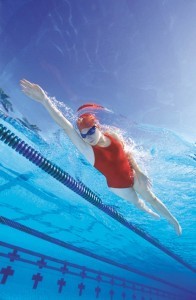
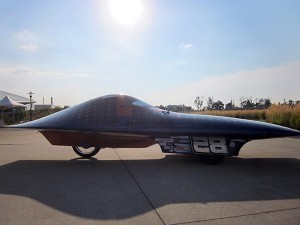
Our daughter Katie’s journey into the world of sports began as a small, skinny 4 year old. We first hit the soccer field with a general feeling of anxiety, not having any idea what to expect. Well, this journey was short lived, as Katie had more interest watching everything except the ball! Next up: Softball. Let’s just say that the dandelions got more attention… In her defense, she got hit in the face with the ball within the first 5 minutes, from a hard-throwing young rising star. She did stick it out for a few seasons, but in the end, so much for ball sports.
As a kid, I was much like my daughter– not real great at ball sports, but I had always taken well to the water. So in looking for sports that didn’t involve a ball, we were naturally drawn to swimming. Why not “like father, like daughter?” At first, we just wanted her to learn to swim– as everyone should. Learning to swim didn’t come without its own challenges: either the water was too cold or she was afraid to put her head under. To our relief, however, something finally clicked, and after a few lessons, she started to take to the water like a fish.
Of course, we needed to run with this new-found skill set and get her involved with other kids with similar interests– so we entered the world of competitive swimming! Summer rec league, to start… and what a start! Right out of the gate, first race, she won her heat, and that was all it took– you could see she was filled with pride! As we became more involved with swimming, it became apparent to us that proper technique would be critical as Katie progressed further into the sport. There is really no reason to commit hundreds– or thousands– of hours of training your mind and muscles to work a certain way, only to find out later that your form is inefficient. It would be much harder to correct these stroke inefficiencies later on, so why not learn the right methods from the start? Enter the Total Immersion Swim Studio!
So, just how did we get involved with the Total Immersion Swim Studio? At about the same time Katie was getting into swimming, I was fully involved as the faculty advisor for our university’s international solar car program and racing team. Just like with Katie and swimming, we were late to the game and had to play catch up. A lot of the technologies could be bought – solar array, electric motor, electronics, and batteries; but what made the real difference is how you handled the inefficiencies. Every little loss of efficiency mattered – aerodynamic drag, rolling resistance, weight and balance. Being an engineer who uses research as one of the most valuable tools, I hit the books and quickly found an e-book by Terry Laughlin: “Swim Ultra-efficient Freestyle! The Fishlike Techniques From Total Immersion.” [Kindle version HERE] I became immersed in the book and couldn’t put it down. Everything made total sense to me, as the approach taken to learning to swim efficiently was very similar to the design of an efficient solar car! One thing that stood out was the importance of your body’s hydrodynamics in the water and how it relates to nature – exactly the same approach to the aerodynamic design of the solar car’s body. The whole idea of efficiency and how it relates to swimming was well thought out and addressed in Terry’s book.
But the best was yet to come! When I first picked up the book, I didn’t realize that the Total Immersion Swim Studio (TISS) was located less than ten miles from where we live. People travel from all over the world to be trained here– what a find! So we reached out to the TISS and set up a meeting. We were greeted at the door by “Miss Alice,” Terry’s wife, and felt an immediate connection. Her enthusiasm was infectious and we couldn’t wait to get started! Miss Alice taught Katie early on how important it was to be an efficient swimmer. She introduced the same techniques that were taught to the adults in T.I. instruction, but at a level that Katie could understand– some teaching drills which stood out were: “Shark fin / Swordfish” [Skating/Switch drills] for her freestyle, and “Show me your shoulders” [emphasizing core rotation] for backstroke.
After a few successful years of summer rec swimming, Katie asked to join our local year round competitive age group swim team, and about that same time she was introduced to “Miss Betsy,” Alice and Terry’s youngest daughter. They had immediate chemistry as “coach to student” and “friend to friend” – which they still enjoy to this day! Katie is currently working on stroke refinement techniques and hopes to one day swim competitively in college and maybe help out at the Swim Studio!
The big takeaways we get from this adventure of watching our daughter progress through the world of swimming are:
She has found something that she is successful at, which makes her proud!
She has had great coaches along the way– summer rec, year-round age group, and at the Total Immersion Swim Studio!
She, and we, have made many great friends!
She has become a very elegant and efficient swimmer, able to effortlessly swim more than a mile, non-stop, when she was just 10 years old.
At the pool you can always spot the swimmers that have had TI training.
More than anything, we just love to watch her swim!
About her own perspective as a swim student learning with Total Immersion, Katie writes:
The Total Immersion Swim Studio has improved my swimming by an incredible amount. I remember when I first started swimming competitively on a summer recreation team when I was an 8 year old– I was pretty new to swimming, so I had terrible technique. My dad noticed that I was really interested in swimming, so he decided to research it more. He eventually stumbled across a book written by Terry Laughlin and was intrigued. He bought the book, looked over some of the technique tips, and decided that we should start going to Total Immersion. The coaches– Alice and Betsy Laughlin–were so nice to me and showed me lots of new ways to improve my swimming. By the next year on the summer rec team, I had already improved so much because of what Total Immersion had taught me, so my parents decided to sign me up for a year-round swimming club. During my experiences at Total Immersion, I learned so much about stroke technique and muscle memory and I would definitely recommend going to TI since I’ve greatly benefited from my time there.
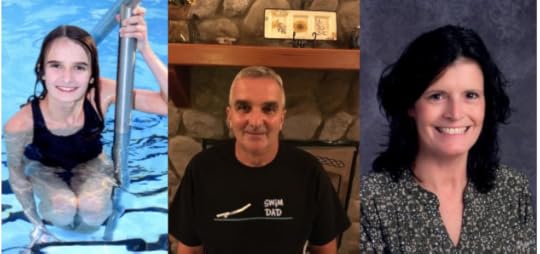 (T.I. swimmer Katie Otis, father Mike Otis, mother Lisa Otis)
(T.I. swimmer Katie Otis, father Mike Otis, mother Lisa Otis)
Katie Otis, a longtime swim student at the Total Immersion Swim Studio in New Paltz, NY, is a 7th grader whose favorite subjects are math and reading. Her favorite sport is swimming and her favorite stroke is butterfly. Her favorite pastime when not in school or swimming is hanging out with friends. Katie’s father, Mike Otis, is an engineering professor at SUNY New Paltz and swim dad, and his favorite pastime when not working or at the pool is traveling with the family and enjoying outdoor sports. Katie’s mother, Lisa Otis, is a 4th grade special ed teacher and her favorite pastime when not working or at the pool is doing fun things with the family.
The post Guest Post: What’s The Link Between Efficient Swimming & Efficient Solar Car Design? appeared first on Total Immersion.
August 3, 2018
Terry Laughlin Memorial Swim in Lake Placid– Register by Aug. 6!

Good news, T.I. swimmers and open water enthusiasts! There’s still time to register HERE for the Terry Laughlin 2 Mile Memorial Cable Swim and the Betsy Owens 1 Mile Memorial Cable Swim at Mirror Lake on Saturday, August 11 in the village of Lake Placid, NY. Registration closes this Monday, August 6, at 11:59pm EDT. As many readers of this blog may recall from his numerous posts about this race over the years, “The Betsy Owens” was Terry’s favorite and most frequently-attended open water event. Many thanks from the Laughlin Family to Terry’s longtime friend Ann Svenson (former director of the Betsy Owens Memorial Swims) for honoring Terry by re-naming the 2 mile event in his memory. It’s a fitting tribute with this event that meant so much to him. Another exciting update is that “the Terry 2 Mile” has just been selected to host the 2 Mile Cable Swim National Championship event in 2020!
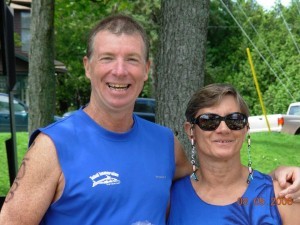 (Terry & Ann Svenson at the 2006 Betsy Owens event– both broke national age-group records in the 1 mile and 2 mile cable swims that year)
(Terry & Ann Svenson at the 2006 Betsy Owens event– both broke national age-group records in the 1 mile and 2 mile cable swims that year)
Svenson, a USMS Long Distance All Star, national record holder, and one of the first Total Immersion coaches, wrote in “Remembering Terry Laughlin,” published last November in “Adirondack Sports”:
“In 2006…Terry broke two US Masters Swimming open water national records in the one-mile and two-mile cable swims (the only open water events for which records are held as they’re swum around a precise quarter-mile cable course) at the Betsy Owens Memorial Race in Mirror Lake, Lake Placid – his favorite swim event. As a result of these swims, Terry achieved Long Distance All-American status and was named to the 2006 USMS Long Distance All Star team. In August 2018, the two-mile cable swim will now be the Terry Laughlin Two-Mile Race, and the one-mile will now be the Betsy Owens One-Mile Race. They were friends and she would be proud to share the bill with him. Terry contributed quarterly swimming columns and photos to Adirondack Sports & Fitness magazine from 2001 to 2010, which were widely read and shared. He always signed his missives ‘Happy Laps’ and it’s his greatest contribution to the swimming world.”
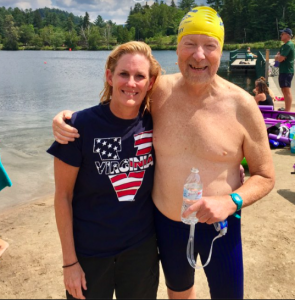
(Terry with Beth O’Connor Baker at the finish of the 2017 Betsy Owens 1-mile. Terry coached Beth to the 1980 Olympic Trials in 200-meter butterfly– last year, both swam the Betsy Owens 1-mile and her 20 y.o. son Ryan won the Betsy Owens 2-mile)
In Terry’s blog post last year, reflecting on the 2017 Betsy Owens, Why I Felt Gratitude and Joy After Finishing 48th of 50, he wrote:
“The Betsy Owens Memorial Cable Swim has been my favorite open water event for, well, ever. It’s swum in Mirror Lake, a body of water of unsurpassed beauty in the center of historic Lake Placid, NY, with a stunning Adirondack Mountain backdrop. The stainless steel cable, anchored a meter below the surface provides the equivalent of a lane line in open water. The entire field is strung along either side of the cable, rather than dispersed, which gives one far more of a feeling of swimming with your fellow OW enthusiasts. And finally, since 2005, it has memorialized my good friend Betsy Owens, who’d been an energetic, dynamic leader of Adirondack Masters until her death from breast cancer in 2004. I’ve missed the event only a few times in nearly 20 years. Participating in it brings incalculable pleasure and richness into my life. Last Saturday I enjoyed a full day in a setting of great natural beauty with a dozen or more good friends, first while swimming, then at a post-race lakeside picnic, and finally for post-picnic beers at the Lake Placid Brewpub, where we have long had a standing appointment each year after Betsy Owens. If at all possible, you’ll find me back at Betsy Owens the second Saturday in August 2018.”
Terry will certainly be there in spirit on August 11th and would be so proud to receive the honor of the 2 Mile bearing his name this year, alongside his friend’s name, Betsy Owens, for the 1 Mile. We hope to see you at the lake!
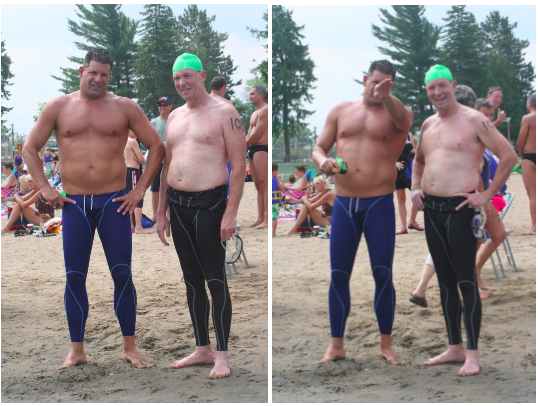
(Terry with longtime friend Steve “Bear” Schtab at the 2005 Betsy Owens– Steve was a star swimmer on the first age-group team Terry coached, at Eastern Queens YMCA in Bellerose, in the mid to late 1970’s)
Enjoy this look back at previous blog posts Terry wrote over the years, recounting his experience preparing for and swimming the Betsy Owens Memorial Cable Swims:
4/20/09: What kind of training does it take to break a National Open Water Record?
8/26/10: A Meditation on Swimming Faster
5/3/13: How Age and Cunning Can Win the Day in Open Water
7/12/13: Enjoyment Meets Improvement
7/29/13:‘Drafting Off’ My Inner Voice
8/26/16: Zero Cancer Swimming: Healing “Exercise” and Striving Together
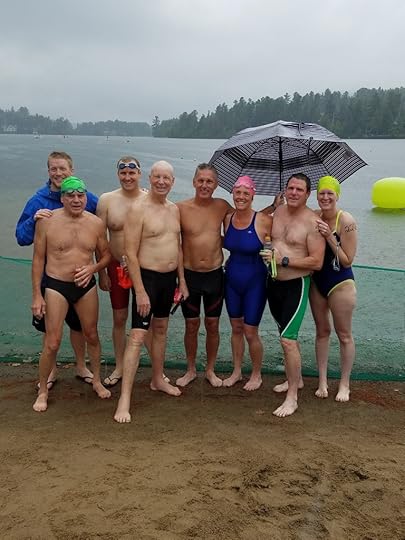
(Terry at the 2016 Betsy Owens with T.I. fan John Lomasney and other members of the Binghamton University Masters Swimmers– “BUMS”– Terry wrote about swimming with John during the 2 Mile in the 2016 blog entry linked above)
The post Terry Laughlin Memorial Swim in Lake Placid– Register by Aug. 6! appeared first on Total Immersion.
July 28, 2018
Terry Featured In NYT Bestseller “Tribe of Mentors” by Tim Ferriss– and FREE Video from “The Tim Ferriss Experiment”

(Terry demos for student Sarah and Tim Ferriss on “The Tim Ferriss Experiment” in 2014)
If you’re a regular reader of this blog, or the blog of NY Times bestselling author and life hack/productivity guru Tim Ferriss, you already know that Tim and Terry became friends after Tim conquered a life-long fear of swimming in 2008 using T.I. techniques. He devoted a chapter of “The 4-Hour Body” to Total Immersion technique and even included T.I. in “The 4-Hour Chef” book as an exemplar of logically sequencing complex skills into a simple progression. In addition, Tim’s podcast with Terry in Oct. 2017– entitled “The Master Who Changed My Life”– was the last long-form interview Terry gave before his passing, a couple weeks later. In the intro to the podcast, Tim writes: “He had a profound impact on me — teaching me to overcome a lifelong fear of water and swimming (read all about it here). But more than that, he’s been an inspiration for the way I’ve done anything since.”
Chapter on Terry in Tim’s newest bestseller: “Tribe of Mentors”
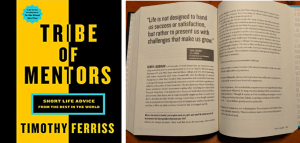
Tim’s new #1 NYT Business Bestseller and #1 Advice/How-To Bestseller– “Tribe of Mentors: Short Life Advice from the Best in the World”– also features a chapter on Terry. We here at T.I. operations had intended to announce his inclusion in the book last autumn, but it got lost in the shuffle since it was published very soon after Terry’s passing. We’re happy to finally announce it here! Below is Tim’s description of the book…Check it out!
“Tribe of Mentors, my newest book, shares short, tactical life advice from 100+ world-class performers. Many of the world’s most famous entrepreneurs, athletes, investors, poker players, and artists are part of the book. The tips and strategies in ‘Tribe of Mentors’ have already changed my life, and I hope the same for you.”
Available to view FREE:
Terry teaching swimming on “The Tim Ferriss Experiment” (2014)
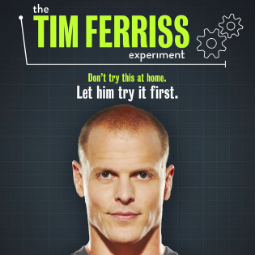
We’re also delighted and appreciative to share that Tim and his team posted the full episode of Terry teaching open water swimming (in 2014) on the show “The Tim Ferriss Experiment.” It was previously only available for purchase on iTunes (and you can still buy it there for $1.99 if you want a permanent copy). This peek into a series of T.I. lessons is available to view for FREE on the Facebook page for the show– follow the link HERE. The 22 minute episode features Terry teaching a fearful swimmer how to swim, with the T.I. approach of deconstructing the stroke into building-block “micro-skills”– and swimming in open ocean within 5 days!
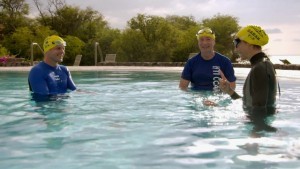
(L-R: Tim, Terry, and Sarah on “The Tim Ferriss Experiment”)
Here’s the episode description:
“Tim and Terry Laughlin head to the tropics to take a fearful fan (Sarah) from zero to hero in record time. She can’t swim a single lap in a pool. Can they get her to long-distance swimming in the open ocean in less than one week? They’ll need all the tools in the toolkit.” #facingfears
To watch a short preview of the episode, check out the trailer on YouTube.
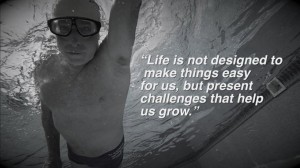
—————————————————————————————————————————-
Related Links:
From “Business Insider” (2015): ‘4-Hour Workweek’ author Tim Ferriss explains how learning to swim in his 30s changed his life
“Smash Fear, Learn Anything”: Tim Ferris’s TED talk describing how he learned to swim with T.I.
2012 post from Terry– “Lesson 1 – Impossible Becomes Possible”: http://www.totalimmersion.net/blog/how-ti-helped-tim-ferriss-bypass-his-previous-failure-points/
2013 post from Terry: How Tim Ferriss Learned to Feel Like Superman
The post Terry Featured In NYT Bestseller “Tribe of Mentors” by Tim Ferriss– and FREE Video from “The Tim Ferriss Experiment” appeared first on Total Immersion.
July 20, 2018
Stroke Thoughts: A Practice Set for Mindful Swimming
The latest installment in an ongoing series of newly-released material from Terry Laughlin’s unpublished  archives
archives
The role of mindfulness is a primary theme that underpins the Total Immersion approach to practicing and teaching swimming, and was a significant influence on Terry’s work over the years. Even when Terry was not overtly highlighting mindfulness as the explicit focus, the importance of mindful attention was always implicit in his nuanced exploration of the minute details in stroke mechanics and the habits of deliberate practice (a topic discussed in last week’s blog). He recognized that the cultivation of mindfulness is a key element in the pursuit of mastery and excellence in any skill.
In addition to the obvious benefits of improved stroke efficiency and faster swimming with more graceful ease, Terry also grew to appreciate the salutary mental/emotional effects of practicing mindful movement. In May of 2017 he contributed a column entitled, “How to Be Mindful While Swimming,” to the “Meditation for Real Life” series in the the N.Y. Times. A great read, that short column focused on swimming as a moving meditation, and gave pithy guidance for practicing present moment attention and sensory awareness in swimming. However, it was an abridged and tightly-edited version of a more expanded article. For clarity and brevity, much of his original draft had to be cut from the final edit, including a useful practice set with more details on technique points. This post, on swimming mindfully with specific “stroke thoughts” (aka: focal points) is the first publication of Terry’s original, unabridged article. Enjoy!
Swimming often devolves into autopilot behavior in which you focus only on getting in the distance you’ve planned, or “following the black line.” This is a lost opportunity. Swimming with a targeted mental focus can also be an immensely rewarding opportunity to practice mindfulness—and a proven way to improve your efficiency. The average swimmer has an almost limitless improvement upside. By swimming mindfully with specific Stroke Thoughts, we can transform routine lap sessions into an immersive form of moving meditation, and an unmatched method of continuous technique refinement.
improving your swimming, rather than just getting laps in. With this mindset of mastery, your goal is to be a better swimmer when you leave the pool.
Start with 4 x 25y/m freestyle repeats, swimming normally. Count strokes on each 25– which itself is an exercise in paying attention– and rate the overall quality of your experience on a scale from 1 to 5 (1= unfocused; 5= deeply focused).
Then, swim a series of 4 to 8 x 25y/m with each of the suggested Stroke Thoughts outlined below. As you begin swimming, tune your sensory awareness by focusing on each individual stroke. Notice the feeling of the wetness on your skin. Feel yourself — buoyant — moving through water. During rest breaks, take cleansing/centering breaths and continue “swimming mentally” by visualizing your Stroke Thought.
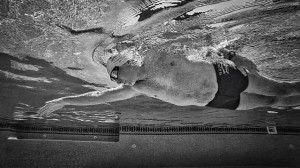
Photo courtesy of Bob Fagan and USIA Video.
Stroke Thought #1: Focus on your breath. As you take breaths, shift your focus from a stroke rhythm to a breathing rhythm, noticing the unbroken alternation of in-breaths and out-breaths. How does your body accommodate to this rhythm? Notice details from inhalation to exhalation, such as: frequency of breath (e.g. bilateral breathing every 3 strokes vs. breathing every other stroke on the same side), volume and rate of air exchanged (long, slow breaths vs. short, fast breaths), and ratio of nose breathing to mouth breathing. Observe how sustainable your breath management is for the pace you’ve set. Do you exhale too fast and run out of air? Or conversely, hold your breath, creating a buildup of CO2 in your lungs and an unpleasant tightness in the chest? Experiment with different variables as you aim to find a sustainable, steady breathing rhythm that is comfortable for you.
Stroke Thought #2: Align head and spine. Completely release the weight of your head to be supported by the water. Head and spine should better align as a result. To reinforce, visualize being towed forward by a line attached to the top of your head, so your head-spine line is both lengthening and always moving in the direction you want to travel.
Stroke Thought #3: Cut a Letter Slot. As you continue with tuned sensory awareness of your stroke, focus on the feel of your arms entering and exiting the water. Feel cool, dry air on your arms briefly; then the wet thickness of the water for a longer period of submersion. Enter your hand (closer to your shoulder than normal) with fingers down to cut a slot (like the letter slot at the post office) in the surface. Forearm should follow hand through that slot. As you do this, observe the sound of your swimming– listen for noise, hearing any splashes or bubbles. Strive to eliminate both. How quietly can you swim?
Stroke Thought #4: Form Lines. After your hand slides through the slot, reach it fully forward, then line up that side of your body—fingertips to toes—behind the lead arm. Continue stroking, forming right-and-left-side lines with each stroke. Assess how long, straight and sleek each line is. Notice how far your arms are reaching in front of you and strive to feel “taller” and more streamlined with each stroke.
Finish with 4 x 25. Choose your favorite Stroke Thought—or a blend of two or more. On your final 25, count strokes and rate the overall quality of your experience to compare with your initial series. On a scale of 1 to 5, how would you rate the quality and consistency of your focus during this set? In a sentence, can you articulate any change in the feel of your stroke?
As you complete your swim, be grateful for your ability to merge mind and body, moving like water.
Related blog posts on swimming and mindfulness:
http://www.totalimmersion.net/blog/swim-health-vitality-swimming-moving-meditation/
http://www.totalimmersion.net/blog/meditation-marines-and-mindful-swimming/
The post Stroke Thoughts: A Practice Set for Mindful Swimming appeared first on Total Immersion.
July 13, 2018
Deliberate Practice
An exclusive excerpt from Terry’s forthcoming final book: Total Immersion: Swimming That Changes Your Life

Terry was nearing completion of the draft for his final book when he passed away in October of 2017, but we’re fortunate that he left behind a considerable body of unreleased material for the team at Total Immersion to publish posthumously. Terry worked steadily on the new book for several years and was eager to release a text that reflected the evolution of his approach to swimming since the revised edition of his bestseller– “the blue and yellow book”– was published in 2004. Reflecting the spirit of “kaizen” (continuous improvement) that Terry embraced, the core principles in the new book remain the same, but his philosophy and methodology about swimming were continuously refined in the 14 years since the original book was updated.
The following post on the topic of “deliberate practice” is a selected excerpt from the unpublished draft of Terry’s final book. This particular excerpt was from a section of the book he entitled “Be Your Own Best Coach”; he wrote this piece last summer, so it’s among the most recent material he worked on before his passing. For his new book, he had chosen the working title, Total Immersion: Swimming That Changes Your Life, after years of hearing swimmers say, “Learning to swim with Total Immersion changed my life!” Receiving this type of enthusiastic feedback prompted him to explore deeper aspects of how transforming one’s swimming can transform other aspects of one’s life. His stated intention with this final book was: “A path for achieving meaningful swimming goals and using swimming as a vehicle for learning, growth,and creating enduring positive change in body, mind, and spirit…”
10,000 Hours: A ‘Brand,’ not a Rule
Deliberate practice refers to a special type of practice that is purposeful and systematic. While regular practice might include mindless repetitions, deliberate practice requires focused attention and is conducted with the specific goal of improving performance.
The most talked about idea from Malcolm Gladwell’s 2008 blockbuster book, Outliers, was the “10,000 Hour Rule.” Gladwell, citing research by K. Anders Ericsson, explained that the key to becoming world-class in any field was to practice a specific task for at least 10,000 hours.
As you might expect, people quickly latched onto the number 10,000 and forgot the details of the argument.
Obviously, there is no magic in the 10,000th hour, but it is true that you need to put in a lot of work to become world-class in any task. However, the important question is this, “What should that work look like? If you want to become great at your craft, what exactly should you do with your 10,000 hours?”
You can’t simply put in time. You have to practice deliberately on a specific skill.
But what, exactly, does deliberate practice look like?
Deliberate practice is when you work on a skill that requires one to three hours of practice to master. If it takes longer than that, then you are working on something that is too complex.
Once you master this tiny behavior, move on to the next micro-skill that takes one to three hours. Continue repeating this process indefinitely.
At age 55, I estimated that I’d accumulated 10,000 lifetime hours of swim training or practice. But relatively little of that was deliberate.
Deliberate practice also ties in quite nicely with the idea of getting 1 percent better each day. Each practice session should be focused on mastering a tiny skill that makes you slightly better at your craft.
The Idea in Practice
This basic method of deliberate practice applies to nearly any behavior, but let’s use head position as an example.
Notice that each practice session focuses on one micro skill– for example, relaxing the neck and releasing the weight of your head into the water– and that each session builds upon the prior skill. Your energy and effort are directed toward something small enough– like imprinting proper head position– that you could at least become sufficiently familiar with it to better recognize when you are off-target.
The self-awareness you achieve in early sessions of deliberate practice is required for succeeding in later sessions as well.
Get the foundation skills right and they help you in every subsequent task or practice. Neglect them and subsequent tasks suffer because of it.
This is what deliberate practice looks like. In swimming, the 10,000 Hour ‘Rule’ is really a way of saying you intend to continue this for life. But again, you can’t just put in the time. You must be obsessed with refining or building upon your current skill set in small ways.
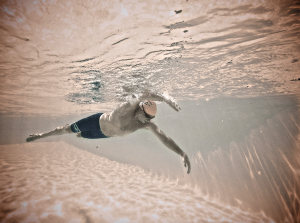
3 Questions for More Deliberate Practice
From what I can tell, the experts who embrace the idea of deliberate practice continually ask themselves three questions…
Do I understand the fundamentals?No matter how advanced they become, experts never lose sight of the fundamentals. In many ways, they are advanced for that very reason: they understand the fundamentals better than anyone else.
Am I working on the next step?There are a lot of smart people who know what the next step is, but never do it. Similarly, there are many people who take action, but waste time working on skills that don’t build upon each other. Experts build knowledge and skills that are cumulative.
What am I missing?One of the greatest pitfalls of the 10,000 Hour Rule is that it makes expertise seems like a finish line that can be crossed. It can’t. Expertise is not a race that can be won– it is simply a process that can be embraced. Experts are constantly asking themselves, “What am I missing? Where are my weaknesses? What new information can help me?”
Expertise is a process, not an outcome.
The post Deliberate Practice appeared first on Total Immersion.
Terry Laughlin's Blog
- Terry Laughlin's profile
- 17 followers


